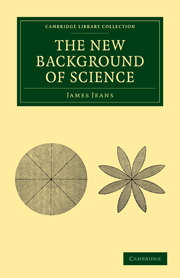Book contents
- Frontmatter
- Contents
- Preface to the First Edition
- Preface to the Second Edition
- Chapter I The Approach to the External World
- Chapter II The Methods of Science
- Chapter III The Framework of the External World—Space and Time
- Chapter IV Mechanism
- Chapter V The Texture of the External World—Matter and Radiation
- Chapter VI Wave-Mechanics
- Chapter VII Indeterminacy
- Chapter VIII Events
- Index
Preface to the First Edition
Published online by Cambridge University Press: 07 September 2010
- Frontmatter
- Contents
- Preface to the First Edition
- Preface to the Second Edition
- Chapter I The Approach to the External World
- Chapter II The Methods of Science
- Chapter III The Framework of the External World—Space and Time
- Chapter IV Mechanism
- Chapter V The Texture of the External World—Matter and Radiation
- Chapter VI Wave-Mechanics
- Chapter VII Indeterminacy
- Chapter VIII Events
- Index
Summary
After undergoing a succession of kaleidoscopic changes, theoretical physics appears to have attained a state of comparative quiescence, in which there is fairly general agreement about essentials. In the following pages I have tried to depict the present situation in broad outline and in the simplest possible terms. I have drawn my picture against a roughly sketched background of rudimentary philosophy–the philosophy of a scientist, not of a metaphysician–because I believe, in common with most scientific workers, that without a background of this kind we can neither see our new knowledge as a consistent whole, nor appreciate its significance to the full. Statements made without reference to such a background–as, for instance, that “an electron consists of waves of probability” or that “the principle of indeterminacy shews that nature is not deterministic”–can convey at best only a minute fraction of the truth.
I have tried to exhibit the new knowledge in such a way that every reader can form his own judgment as to its philosophical implications. There is room for much legitimate difference of opinion as to what precisely these are; yet few, I think, will be found to doubt that some reorientation of scientific thought is called for.
- Type
- Chapter
- Information
- The New Background of Science , pp. viiPublisher: Cambridge University PressPrint publication year: 2009First published in: 1931

